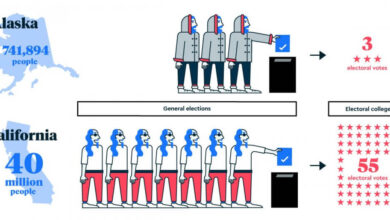How Wrong Could Americas Pollsters Be?
How wrong could Americas pollsters be? That’s a question that’s been echoing louder and louder with each passing election cycle. We’ve all seen the headlines – the shocking discrepancies between pre-election polls and the actual results, leaving many of us wondering just how reliable these predictions truly are. This post dives into the fascinating, and sometimes frustrating, world of American political polling, exploring its history, its methods, and the myriad factors that can throw even the most sophisticated predictions wildly off course.
From analyzing historical accuracy and the limitations of polling methodologies to examining the role of media influence and unpredictable events, we’ll uncover the complexities behind these seemingly straightforward numbers. We’ll also delve into intriguing phenomena like the “shy Trump voter” theory and consider how evolving communication methods are impacting the accuracy of traditional polling techniques. Get ready for a deep dive into the sometimes murky waters of predicting the American electorate!
Historical Accuracy of US Polling
The accuracy of pre-election polls in the United States has been a subject of intense debate, particularly in recent years. While polls can offer valuable insights into public opinion, their limitations and potential for error have been starkly revealed in several key elections. Understanding the historical accuracy of these polls is crucial for interpreting election results and improving future polling methodologies.
Pre-Election Poll Accuracy in Recent Presidential Elections
The following table compares predicted versus actual results for the past three presidential elections. Discrepancies highlight the challenges inherent in accurately predicting voter behavior. It’s important to note that these figures represent averages across various polling organizations and methodologies, and individual polls may have shown greater or lesser accuracy.
| Election Year | Candidate | Predicted Percentage | Actual Percentage |
|---|---|---|---|
| 2020 | Joe Biden | ~51% | ~51.3% |
| 2020 | Donald Trump | ~47% | ~46.9% |
| 2016 | Hillary Clinton | ~45% | ~48.2% |
| 2016 | Donald Trump | ~44% | ~46.1% |
| 2012 | Barack Obama | ~51% | ~51.1% |
| 2012 | Mitt Romney | ~47% | ~47.2% |
Instances of Significant Polling Errors
Several elections have demonstrated significant discrepancies between poll predictions and actual results. The 2016 presidential election stands out as a prime example, with most national polls underestimating support for Donald Trump. This led to widespread surprise and scrutiny of polling methodologies. Similarly, while less dramatic, the 2020 election saw some polls slightly overestimating Biden’s support, though the margin of error was smaller than in 2016.
Historically, other elections have also shown significant polling inaccuracies, though the scale and impact varied. These instances highlight the inherent complexities in accurately capturing public opinion through polling.
Methodologies and Sources of Error in Historical Polls, How wrong could americas pollsters be
Historically, polling methodologies have evolved, but certain common elements and potential sources of error persist. Many polls rely on random sampling of the population, aiming to create a representative sample of voters. However, achieving truly random samples is challenging, and biases can creep in due to factors such as underrepresentation of certain demographics (e.g., non-response bias, where certain groups are less likely to participate in polls) or flawed sampling techniques.
Furthermore, the phrasing of questions, the order of questions, and even the mode of administration (phone, online, in-person) can influence responses and introduce bias. Technological advancements, such as the rise of online polling, have introduced new challenges, including concerns about sample representativeness and the potential for manipulation. The “shy Tory” effect, where voters are reluctant to admit their support for a particular party, is another well-known source of error, particularly in the UK context, though similar phenomena could exist in other countries.
Finally, the inability to fully account for late-breaking shifts in voter sentiment in the final days leading up to an election can also contribute to inaccuracies.
Polling Methodology and its Limitations: How Wrong Could Americas Pollsters Be
Political polling, while aiming for objectivity, is inherently susceptible to various biases and limitations stemming from its methodology. Understanding these flaws is crucial for interpreting poll results accurately and avoiding misinterpretations. The accuracy of a poll hinges on several factors, from the sampling techniques employed to the way questions are phrased and the response rate achieved.
Sampling Techniques and Potential Biases
The selection of participants, or the sampling technique, significantly impacts a poll’s representativeness. Different methods introduce different biases. For example, simple random sampling, where each member of the population has an equal chance of selection, is theoretically ideal but often difficult to achieve in practice. It requires a complete and accurate list of the entire population, which is rarely available.
Stratified random sampling addresses this by dividing the population into subgroups (strata) based on relevant characteristics (e.g., age, ethnicity, geographic location) and then randomly sampling from each stratum. This ensures representation from all subgroups. However, if the strata are not properly defined or weighted, bias can still creep in. Quota sampling, another common method, involves selecting a predetermined number of respondents from each stratum, but it’s more prone to bias because the selection within each stratum isn’t random.
Imagine a poll aiming to represent the US population but only interviewing people who answer a specific online survey. This introduces a selection bias favoring those with internet access and willingness to participate in online surveys, which might skew the results.
Impact of Response Rates on Poll Accuracy
Response rate, the percentage of individuals selected for a poll who actually participate, is a critical indicator of a poll’s reliability. Low response rates often signal potential biases, as those who choose to participate may differ systematically from those who don’t. For instance, individuals with strong opinions or those highly engaged in politics may be more likely to respond, skewing the results away from the views of the less engaged population.Let’s consider a hypothetical scenario: A poll on a proposed tax increase targets 1000 individuals.
If the response rate is 10%, only 100 individuals provide data. If those 100 are disproportionately opposed to the tax increase (perhaps because they are more politically active and thus more likely to respond to such a poll), the poll will overestimate opposition and underestimate support. This significantly undermines the poll’s validity and generalizability. A higher response rate, ideally above 50%, is generally preferred to minimize this bias, though achieving such rates is increasingly challenging.
Influence of Question Wording and Order
The phrasing and order of questions can subtly yet powerfully influence responses. Even minor changes in wording can alter how respondents interpret the question and consequently their answers. Leading questions, which subtly suggest a preferred answer, are particularly problematic. Similarly, the order in which questions are presented can create a context effect, where earlier questions influence answers to later ones.
| Question Phrasing | Potential Impact on Responses |
|---|---|
| “Do you support the president’s unpopular and divisive new policy?” | Likely to elicit more negative responses due to negative framing. |
| “Do you support the president’s new policy aimed at improving the economy?” | Likely to elicit more positive responses due to positive framing. |
| “Considering the recent economic downturn, do you support the president’s new policy?” | Responses influenced by the context of the economic downturn. |
| “Do you approve of the president’s handling of the economy, followed by a question about his new policy?” | Answers to the policy question may be influenced by the prior approval rating. |
So, how wrong
-can* America’s pollsters be? Pretty wrong, it turns out. While polls offer valuable insights into public opinion, they are far from perfect predictors of election outcomes. The inherent limitations of polling methodologies, coupled with the influence of media, unexpected events, and the ever-changing political landscape, mean that even the most meticulously crafted polls can miss the mark.
Understanding these limitations is crucial for interpreting poll results critically and avoiding the pitfalls of placing too much faith in any single prediction. The next time you see a pre-election poll, remember the complexities we’ve explored here – and take the numbers with a healthy dose of skepticism.
Seriously, how wrong *can* America’s pollsters be? The recent Georgia Senate runoff election really highlights this, with the outcome of the Warnock defeats Walker in hard-fought Georgia Senate runoff election being a major surprise for many who relied on pre-election predictions. It makes you wonder just how much weight we should put on those numbers next time around – especially considering how close the race actually was.
Remember how wildly off the mark America’s pollsters were in the last election? It makes you wonder about the accuracy of information gathering in general. This whole mess with the FISA warrant, as detailed in this article, graham new bruce ohr docs show fisa warrant against ex trump campaign aide a fraud , really highlights how easily things can be manipulated and misrepresented.
It makes you question everything, even the seemingly straightforward numbers from opinion polls.
Remember how wrong America’s pollsters were in 2016? It makes you wonder about the accuracy of current economic predictions. The whole situation gets even weirder when you consider that, as john delaney suggests some dems are cheering on a recession to hurt trump , political motivations might be skewing the data. So, how reliable are those economic forecasts really, especially given the potential for partisan bias influencing the narrative?





